Cushion Spurge Euphorbia epithymoides

ABOUT
The Euphorbia epithymoides, also known as cushion spurge, is a perennial plant that boasts a striking appearance with a dense, mounding habit. Its foliage is a vibrant green, and the leaves are small, oval-shaped, and arranged in close spirals around the stems, providing a lush, bushy look. During spring, it becomes even more eye-catching when it is topped with bright yellow-green flowering bracts. These bracts are often mistaken for flowers, though the actual flowers are tiny and tucked within the bracts. The plant's showy display creates a bold splash of color, which can brighten up any garden space. As the seasons change, the foliage may take on a reddish or purple tinge, adding to the visual interest of this garden favorite.
About this plant
 Names
NamesFamily
Euphorbiaceae
Synonyms
Cushion Spurge, Polychrome Spurge, Euphorbia Polychroma
Common names
Euphorbia polychroma, Tithymalus polychromus
 Toxicity
ToxicityTo humans
The most common common name for Euphorbia epithymoides is cushion spurge. Cushion spurge contains a toxic white latex sap that can cause irritation when it comes in contact with skin, mucous membranes, or the eyes. If ingested, this sap can cause symptoms such as nausea, vomiting, and diarrhea. In severe cases, ingesting the plant can lead to more serious symptoms, including weakness, lethargy, and in some cases, seizures or coma. It is important to avoid consuming any part of the cushion spurge and to wash hands thoroughly after handling the plant to prevent accidental ingestion or contact with the eyes and mouth.
To pets
Cushion spurge is toxic to pets due to the presence of a milky latex sap found throughout the plant. If a pet ingests any part of the cushion spurge, they may experience symptoms such as vomiting, diarrhea, drooling, and abdominal pain. In severe cases, ingestion can cause more serious signs like tremors or seizures. It is important to keep pets away from this plant and to seek veterinary care immediately if you suspect your pet has ingested any part of the cushion spurge.
 Characteristics
CharacteristicsLife cycle
Perennials
Foliage type
Deciduous
Color of leaves
Green
Flower color
Yellow
Height
1 foot 2 inches (35-40 cm)
Spread
1 foot 2 inches (35-40 cm)
Plant type
Herb
Hardiness zones
4
Native area
Europe
Benefits
 General Benefits
General Benefits- Easy to care for – Euphorbia epithymoides, also known as cushion spurge, is a low-maintenance plant that adapts well to a variety of conditions.
- Drought tolerance – Once established, cushion spurge can tolerate periods of dryness, making it suitable for xeriscaping or drought-prone gardens.
- Spring color – This plant offers vibrant green-yellow flowers in the spring that can brighten up any garden space.
- Ground cover – Cushion spurge forms a dense mat of foliage, which can help suppress weeds and cover bare spots in the landscape.
- Attracts pollinators – Its flowers can attract beneficial insects such as bees and butterflies, enhancing pollination in the garden.
- Deer resistant – The plant is not a preferred choice for deer, making it an excellent option for gardens in areas with a high deer population.
- Seasonal interest – In autumn, the foliage often turns a striking red or purple, adding a splash of color to the fall garden landscape.
- Erosion control – The root system of cushion spurge can help stabilize soil, reducing erosion on slopes or in areas prone to soil degradation.
- Companion planting – Its unique color and structure make it suitable for pairing with a variety of other plants, enhancing overall garden design.
- Low fertilizer needs – Euphorbia epithymoides generally thrives with minimal fertilization, making it a sustainable choice for gardeners looking to reduce chemical use.
 Medical Properties
Medical PropertiesThis plant is not used for medical purposes.
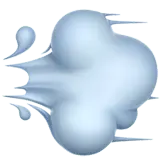 Air-purifying Qualities
Air-purifying QualitiesThis plant is not specifically known for air purifying qualities.
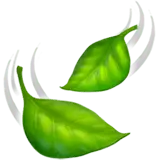 Other Uses
Other Uses- Euphorbia epithymoides, commonly known as cushion spurge, can be used as a natural dye; its bright yellow flowers may yield color for fabrics and textiles.
- The milky sap of cushion spurge contains latex, which can be used as a natural adhesive for small household tasks, although it should be used with caution as it can be irritating to the skin.
- In landscape design, cushion spurge is valued for its striking foliage and can be used to create visual contrasts in rock gardens and borders.
- Due to its unique form, the plant can be utilized in dried flower arrangements to add texture and a pop of color.
- Cushion spurge can serve as a natural pest deterrent in the garden as some insects and animals tend to avoid its toxic sap.
- This plant is often used in xeriscaping, a landscaping method that reduces or eliminates the need for supplemental water from irrigation.
- When planted in clusters, cushion spurge can act as a groundcover, which helps to suppress weeds and minimize soil erosion.
- In educational settings, cushion spurge can be used to teach botany students about plant defenses and adaptations, specifically its toxic sap.
- Euphorbia epithymoides can be used in container gardens to create visually appealing arrangements due to its compact, mounded shape.
- The plant can also play a role in seasonal garden displays, with its vibrant springtime colors signaling the end of winter.
Interesting Facts
 Feng Shui
Feng ShuiThe Cushion Spurge is not used in Feng Shui practice.
 Zodiac Sign Compitability
Zodiac Sign CompitabilityThe Cushion Spurge is not used in astrology practice.
 Plant Symbolism
Plant Symbolism- Resilience: Euphorbia epithymoides, commonly known as cushion spurge, features a hardy nature that allows it to thrive in tough conditions, representing enduring spirit and the ability to overcome adversity.
- Protection: With its toxic sap, cushion spurge symbolizes protection and deterrence, acting as a natural guard against harm and negative forces.
- Renewal: As cushion spurge dies back to the ground each winter and returns in spring, it symbolizes renewal, rebirth, and the cyclic nature of life.
- Caution: The plant’s toxic sap cautions us to be careful and mindful in our actions, symbolizing the importance of awareness and discretion.
 Water
WaterCushion spurge should be watered deeply whenever the top inch of soil feels dry to the touch, which might be roughly once a week, depending on environmental conditions. Irrigate with about 1 gallon of water per plant to ensure the soil is moistened well, but be careful not to overwater as this plant prefers drier conditions. During the growing season in spring and early summer, water needs may increase, but reduce watering in the fall and virtually eliminate it in the winter when the plant is dormant.
 Light
LightCushion spurge thrives in full sun to partial shade. It is best to place it in a spot where it can enjoy at least six hours of direct sunlight daily. Dappled shade during the hottest part of the day can help prevent scorching in regions with intense summer sun.
 Temperature
TemperatureCushion spurge is hardy and can tolerate a range of temperatures, withstanding minimum winter temperatures down to -30 degrees Fahrenheit. It performs best when the temperatures are between 60 and 75 degrees Fahrenheit, which are ideal conditions for growth. Excessive heat can be tolerated especially if there is adequate watering, but generally, extreme temperature fluctuations should be avoided.
 Pruning
PruningPrune cushion spurge to remove spent flowers and control its shape; this is best done in early summer after the plant has flowered. It can also be cut back in late fall or early winter to tidy up the plant and promote bushier growth for the following season. Pruning every year or every other year is generally enough to keep cushion spurge healthy.
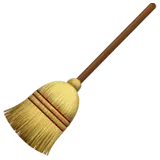 Cleaning
CleaningAs needed
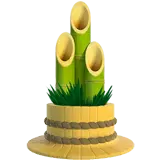 Soil
SoilCushion spurge thrives best in a well-draining soil mix with some organic matter. Ideal soil pH for this plant is slightly acidic to neutral, ranging from 6.0 to 7.0. A mixture of loam, sand, and compost in equal parts with a bit of peat moss can promote healthy growth and drainage.
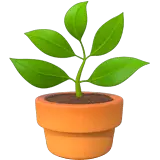 Repotting
RepottingCushion spurge does not need frequent repotting; it can be repotted every 2-3 years. It's quite adaptable but should be repotted if it outgrows its container or the soil becomes compacted.
 Humidity & Misting
Humidity & MistingCushion spurge prefers average room humidity levels; it does not require high humidity. Consistent moisture without waterlogging suits it best, avoiding too much dry air or excessively damp conditions.
 Suitable locations
Suitable locationsIndoor
Provide bright light, well-draining soil, and moderate watering.
Outdoor
Plant in full sun to partial shade, in well-draining soil.
Hardiness zone
4-8 USDA
 Life cycle
Life cycleEuphorbia epithymoides, commonly known as Cushion Spurge, begins its life cycle as a seed that germinates in the spring when soil temperatures warm. The seedling quickly grows into a herbaceous perennial plant, forming a compact, bushy mound with light green leaves. By mid to late spring, Euphorbia epithymoides blooms, producing clusters of bright yellow-green flower bracts that stand out in the garden. After flowering, the plant may go dormant in summer if temperatures are too high or conditions too dry. In autumn, the foliage often takes on a red or purple tinge before the plant retreats into dormancy for the winter. Each year, the plant re-emerges from its rootstock in spring, repeating its growth and reproductive cycle.
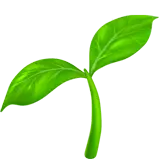 Propogation
PropogationPropogation time
Spring
The Euphorbia epithymoides, commonly known as Cushion Spurge, is commonly propagated by seed or division. However, the most popular method is division, which is ideally done in early spring or fall. This involves carefully digging up the plant and dividing it into smaller sections. Each section should have at least a few shoots and a portion of the root system. Replant the divisions immediately at the same depth they were previously growing, spacing them about 12 inches (approximately 30 centimeters) apart to allow for growth. Water the new plantings thoroughly to help establish them. This clump-forming perennial responds well to division and it helps to revitalize older plants that might be losing their vigor.


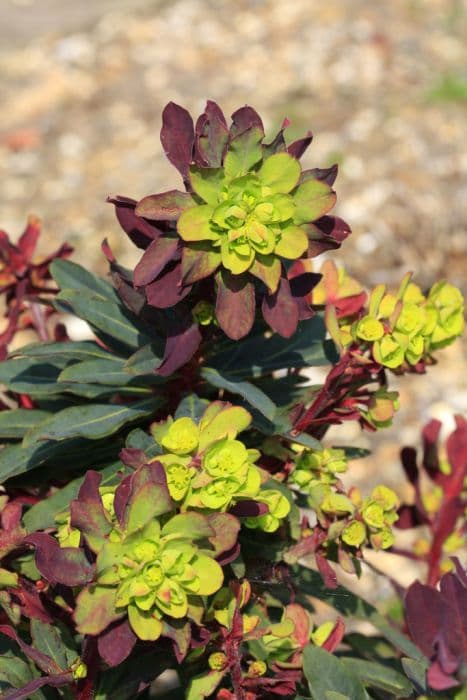
![Spurge [Blackbird]](/_next/image?url=https%3A%2F%2Fplants-admin.emdemapps.com%2Fimages%2Fplants%2F%2Fimages%2F604b535f37783.png&w=640&q=75)





